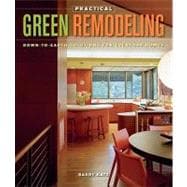
A leading proponent of green building, BARRY KATZ has more than 20 years’ experience in new home construction and remodeling. His Connecticut business is exclusively dedicated to sustainable construction and green consulting. A LEED-accredited (The Leadership in Energy and Environmental Design Green Building Rating System™) professional, Katz was the recipient of the 2007 HOBI Award for Best Green House from the Connecticut Association of Homebuilders
The New copy of this book will include any supplemental materials advertised. Please check the title of the book to determine if it should include any access cards, study guides, lab manuals, CDs, etc.
The Used, Rental and eBook copies of this book are not guaranteed to include any supplemental materials. Typically, only the book itself is included. This is true even if the title states it includes any access cards, study guides, lab manuals, CDs, etc.
First things first: This is not a how-to book. Unlike a lot of books about home remodeling, there are no step-by-step instructions, no tool or materials lists, no advice from the pros for the do-it-yourselfer. Instead, this is a what-to book. After all, before you get to the how-to stage, you need a vision of what you want to do. In this book, I suggest some new ways of thinking about what makes for a successful remodeling project. Is it enough to create more living or storage space, a more convenient floor plan, a nicer kitchen or bathroom? Is it enough simply to make your home more attractive?
Here’s another question. What creates value? One of the first things homeowners want to know about any improvement is, will it be a good investment? Will the added value justify the expense? But what is our standard for judging value? Is it just about how much the home will sell for?
Most home improvements do not add as much value to the house as they initially cost. A new kitchen that costs $50,000 typically adds less than $40,000 to the home’s resale value. On average, most renovations add anywhere from 65% to 85% of their cost to the home’s value. So why do we do it? The answer for most people is that part of the value comes from the added enjoyment or functionality they get from the newly improved home. You might, for example, select a particularly attractive ceramic tile for your bathroom just because you like it, even though it costs more than a cheaper option that doesn’t turn you on. When you eventually sell the house, it is unlikely that your choice of tile will alter the price a buyer is willing to pay. But every day, when you walked into the bathroom it gave you pleasure. That’s worth something.
Adding a deck to the back of your house typically adds about 75% of its cost to the home’s value. But over the years you’ll spend many summer evenings relaxing on that deck, barbequing, entertaining friends and family. The pleasure you get from having that deck means that, for you, it was money well spent.
But what about less tangible--or at least, less visible--improvements? If you choose nontoxic materials that don’t endanger your family’s health, isn’t that worth something, even if the materials cost slightly more? What is the return on an investment that provides improved indoor air quality, reducing the likelihood that your children will suffer with allergies or asthma?
What if you have strong convictions about the environment? You might happily donate money to the World Wildlife Fund to help them fight deforestation in tropical rain forests. You don’t expect any return other than the knowledge that you helped a little bit. But you know that if enough people do the same it will have a meaningful impact.
But what about spending a little more for sustainably harvested lumber? It won’t have any direct impact on your daily life. But as more people make that choice it grows the market for sustainable lumber, which drives down the price. As the price goes down, illegal harvesting in rainforests becomes less profitable and a vital resource is preserved. Whether any particular choice adds to your enjoyment of the house, or your sense of pride in being a good citizen of Planet Earth, it is clear that not every decision you make is based on its value as an investment.
Still, in many ways, green remodeling is a sound financial investment. Investing in energy efficiency might cost a bit more up front, but you come out way ahead because the savings on your utility bills are greater than the small increase in your mortgage payment. It is an investment that pays for itself, and then continues paying dividends as long as you own your home--and when you go to sell it. A growing body of evidence suggests that buyers are willing to pay more for energy-efficient green homes, and that such homes sell faster than non-green homes. As more people become aware of the benefits of living in healthy, energy-efficient homes it is very likely those homes will sell at a significant premium, while energy hogs with poor indoor air quality will lose value.
By presenting a selection of successful green remodeling projects, in all price ranges, from all over the country, I hope to inspire you to think about what you might do to make your own home greener. And to give you a wish list, and a what-to list: what to ask your architect or designer, what to ask your contractor, what to ask the heating contractor, what to ask a landscape designer, what to ask about the materials that will go into your remodel, what to ask about indoor air quality, what to think about when choosing lighting, appliances, plumbing fixtures, cabinets, countertops, paint, flooring…in short, what to look for in the way of greener, more sustainable everything.